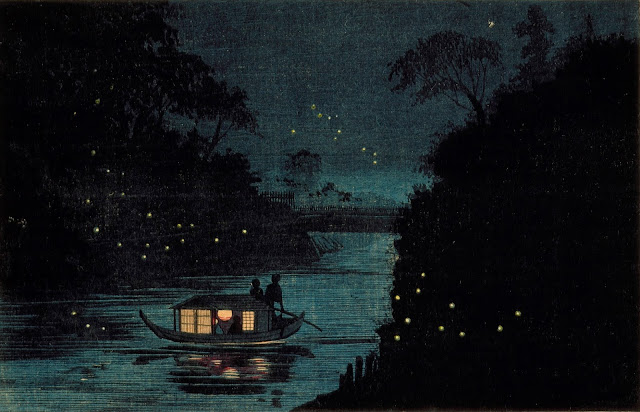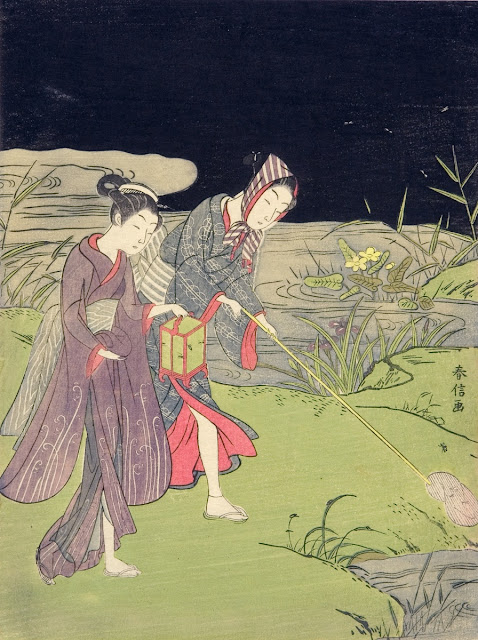Hotaru and Haiku
 |
| Ochanomizu hotaru. Kobayashi Kiyochika, circa 1880 |
There is a soft and subtle impression on fireflies which
makes them very interesting. Their feeble twinkling and slow flying like a
flare moved in the dark. The attraction of these luminous creatures led to the
development of many folk tales, myths, superstitions, and poems related
to fireflies in various cultural settings.
In Indonesia, for example, it was said that fireflies come from the nails of the dead. In ancient China, fireflies were believed to
originate from burning grass. Ancient Chinese manuscripts suggest that a
popular hobby in summer was catching fireflies and placing them in transparent
boxes, to be used as lanterns. Meanwhile, in the Victorian tradition, England,
there is a superstition that if fireflies enter the house, it means that soon
someone will die in that house.
Fireflies also frequently appear in Native American
folklore. In an Apache tribe legend, there is a story of trickster fox who
tries to steal fire from a village of fireflies. The fox get his own tail on fire with a pieace of burning bark. The fox escaped and gave
the bark to the Eagle, which took it flying and spread embers around the world.
In this way the Apache were first introduced to fire.
Most interesting is in Japan, which has a special liking for
these insects which they call "hotaru". Having lived in Tokyo for
almost five years, I can testify of how the hot summer there stings all our
senses. The non-stop vibrating sound of cicadas throughout the day, and flocks of
fireflies at night along the banks of the river that I often pass.
Since long ago the sight of fireflies on a summer night has been a highly anticipated show. Until now, several places in Japan routinely hold firefly festivals — hotaru matsuri — by releasing thousands of fireflies which in Japanese culture are associated with the spirits of warriors who died on the battlefield.
In Kyoto, for example, there is a famous firefly viewing
tour along a section of road dubbed the Philosopher's Path, a narrow strip on
the banks of a small river that connects to Lake Biwa at the foot of
Higashiyama.
In popular culture there is the song "Hotaru no Hikari (Light of the Fireflies)" which is perhaps one of the most recognizable Japanese songs, often sung at farewells, such as at graduation ceremonies, event closings, and year-end. There is also a famous children's song called "Hotaru Koi (Fireflies Come Here)."
Hotaru also inspired lots of anime and movie, one of the most famous is "Hotaru no Haka (Grave of Fireflies)" in 1988, an animation production work of Studio Ghibli, considered to be one of the most powerful anti-war movies ever made.
Japanese Zen Buddhism makes hotaru a symbol for its central concept
of the brevity of life. In Zen, hotaru has a close affinity to the transcience which is
interpreted in a positive light. Weak but beautiful fireflies when seen in
large numbers in the pine forest or in the meadow at night, just a perfect way to tell about the poignancy of our own lives: short and fleeting, but also everlasting and beautiful.
With their pleasing and soft appeal, it's no wonder that fireflies are also often used in poetic expressions and have entered the tradition of haiku. Since the 8th century, in the Man'you-shu anthology, the firefly has been a metaphor for passionate love of poetry.
Izumi Shikibu, who is considered to be the greatest female poet of
the Heian period, wrote this haiku to describe the longing she feels
for her deceased lover:
Flickering fireflies in the valley
Like the light of my longing body
The great seventeenth-century poet Matsuo Basho turned his
attention to these little creatures with short lifetimes, in order to remember
our own limitations but remain hopeful:
Katsura Nobuko (1914–2004) female poet writer of modern
haiku whose early poetry was rather erotic, describing a gathering on a summer
evening:
to meet him
firefly night
The firefly with its delicate wings is a reminder of the
need for submission in the face of the majesty and mystery of the universe.
Kobayasi Issa, an 18th century Buddhist priest who was also a haiku master,
wrote 230 poems about fireflies. In one of his most famous haiku, he records a
moment of silence as time passes more slowly:
These haikus captures brief, enlightening moments from the presence of fireflies. Its weak flickering light, just like its body and life, can inspire poetic expression and reach eternity in the works of various cultures.
Fireflies in their tenderness and fragility give us affirmation, how precious are every life we encounter in the middle of the vast universe, in which we are also nothing more than a grain of dust.
Even the fragile and ephemeral lights in the dark can spark undying hopes and remembrance that bring up happiness for the moment.
That's the gift of Hotaru.
 |
| Hunting for fireflies.Harunobu Suzuki 1767-1768 |

Komentar
Posting Komentar